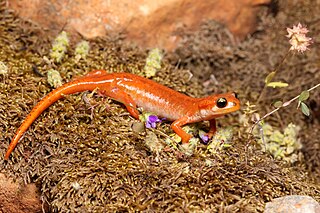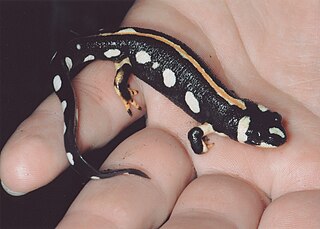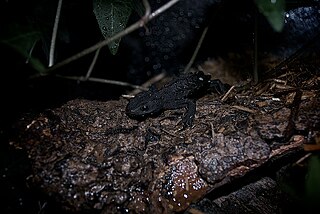
The palmate newt is a species of newt found in Western Europe, from Great Britain to the northern Iberian peninsula. It is 5–9.5 cm (2.0–3.7 in) long and olive or brown with some dark spots. The underside is yellow to orange, and the throat, unlike in the similar smooth newt, always unspotted. A dark stripe runs along the head and through the eyes. Breeding males develop a distinct filament on the end of their tail, strongly webbed hind feet, and a low, smooth crest on their back.

Salamandridae is a family of salamanders consisting of true salamanders and newts. Salamandrids are distinguished from other salamanders by the lack of rib or costal grooves along the sides of their bodies and by their rough skin. Their skin is very granular because of the number of poison glands. They also lack nasolabial grooves. Most species of Salamandridae have moveable eyelids but lack lacrimal glands.

Tylototriton verrucosus is a species of newt found in the Indian subcontinent and Southeast Asia. Common names include: Himalayan newt, crocodile newt, crocodile salamander, Himalayan salamander, red knobby newt.

Anderson's crocodile newt, Anderson's newt, Ryukyu spiny newt, or Japanese warty newt is a species of salamander in the family Salamandridae found in the Ryukyu Islands of Japan, and, at least formerly, Mount Guanyin in northern Taiwan, where it is now believed to be extinct.

The Pyrenean brook salamander or Pyrenean newt, Calotriton asper, is a largely aquatic species of salamander in the family Salamandridae. It is found in the Pyrenees of Andorra, France, and Spain. The IUCN lists it as least concern.

The Corsican brook salamander or Corsican mountain newt is a species of salamander in the family Salamandridae. It is endemic to Corsica, an island in the Mediterranean Sea.
Lyciasalamandra flavimembris, the Marmaris Lycian salamander or Marmaris salamander, is a species of salamander in the family Salamandridae. It is endemic to Turkey and is found along the southwestern Anatolian coast between Marmaris and Ula. It was first described as subspecies of Mertensiella luschani, now Lyciasalamandra luschani.

Luschan's salamander or Lycian salamander is a species of salamander in the family Salamandridae. It is found in the southwestern Anatolia in Turkey and in adjacent Greece.

Neurergus is a genus of salamanders, more specifically newts, in the family Salamandridae. They are found in the Middle East, and are kept and bred in captivity for their bright colors. In nature, they inhabit streams and small rivers, and the surrounding forests or shrublands. All of the Neurergus are considered threatened species, primarily due to destruction of habitat and overcollection for the pet trade.

Neurergus kaiseri, the Luristan newt, Kaiser's mountain newt, Kaiser's spotted newt or emperor spotted newt, is a species of very colourful salamander in the family Salamandridae. It is endemic to the southern Zagros Mountains in Iran where it is known from just four streams. Populations of this newt have been declining and the International Union for Conservation of Nature has rated it as "vulnerable". A captive breeding programme has been established in several zoos.

The Algerian ribbed newt is a species of salamander in the family Salamandridae found in Algeria and Tunisia. The natural habitats of this newt are rivers, intermittent rivers, swamps, cisterns, freshwater marshes, intermittent freshwater marshes, and ponds. It is threatened by habitat destruction.

The southern marbled newt or pygmy marbled newt is a species of salamander in the family Salamandridae. It is found in Portugal and Spain. Its natural habitats are temperate forests, Mediterranean-type shrubby vegetation, rivers, intermittent rivers, freshwater marshes, intermittent freshwater marshes, arable land, pastureland, rural gardens, water storage areas, ponds, open excavations, irrigated land, canals and ditches. It is threatened by habitat loss.

The Wenxian knobby newt or Wenxian knobby salamander is a species of salamander in the family Salamandridae. It is endemic to central China. Its type locality is Wen County in Gansu, or in Chinese: 文县; pinyin: Wénxiàn, hence the name.

A newt is a salamander in the subfamily Pleurodelinae. The terrestrial juvenile phase is called an eft. Unlike other members of the family Salamandridae, newts are semiaquatic, alternating between aquatic and terrestrial habitats. Not all aquatic salamanders are considered newts, however. More than 100 known species of newts are found in North America, Europe, North Africa and Asia. Newts metamorphose through three distinct developmental life stages: aquatic larva, terrestrial juvenile (eft), and adult. Adult newts have lizard-like bodies and return to the water every year to breed, otherwise living in humid, cover-rich land habitats.

There are 14 species of amphibians and 5 species of reptiles known to occur in Mount Rainier National Park.

Tylototriton himalayanus is a species of salamander in the family Salamandridae. It is known from the Ilam District in eastern Nepal, Darjeeling in northwestern India, and western Bhutan. It is one of the only two species of salamanders found in India.
Pachytriton inexpectatus is a species of salamander in the family Salamandridae. It is endemic to southern China and found in the Guizhou, Hunan, Guangdong, and Guangxi provinces. Its type locality is Mount Dayao of Jinxiu Yao Autonomous County, Guangxi. Prior to naming of this species in 2011, it was confused with Pachytriton labiatus. It is one of the several species that can appear in the pet trade as paddletail newt. The specific name inexpectatus is Latin meaning "unexpected" and refers to finding a species that is common in pet trade but lacked formal scientific description. Common name Yaoshan stout newt has been coined specifically for this species.

Schmidtler's smooth newt is a newt species found from northwestern Greece and southeast Bulgaria over East Thrace across the Bosphorus to northwest Anatolia. Its range borders that of the smooth newt, the Greek smooth newt and Kosswig's smooth newt to the north, west, and east, respectively.















